Related Research Articles
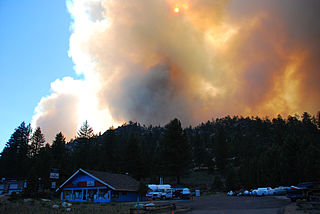
The Angora Fire was a 2007 wind-driven wildfire in El Dorado County, California. It started near North Upper Truckee Road subdivision near Angora Lakes, Fallen Leaf Lake, Echo Lake and South Lake Tahoe, California around 2:15 PM on Sunday, June 24, 2007, as a result of an illegal campfire. As of July 2, 2007, the fire was 100% contained, and 100% control was achieved on July 10. The fire burned 3,100 acres (12.5 km2), destroyed 242 residences and 67 commercial structures, and damaged 35 other homes. At the peak of the fire, there were as many as 2,180 firefighters involved in battling the blaze. The fire cost $13.5 million to fight and caused at least $150 million in property damage.
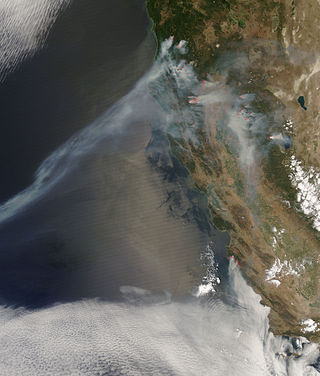
The 2008 California wildfire season was one of the most devastating in the state of the 21st century. While 6,255 fires occurred, about two-thirds as many as in 2007, the total area burned— 1,593,690 acres —far exceeded that of previous years.

The B&B Complex fires were a linked pair of wildfires that together burned 90,769 acres (367.33 km2) of Oregon forest during the summer of 2003. The fire complex began as two separate fires, the Bear Butte Fire and the Booth Fire. The two fires were reported on the same day and eventually burned together, forming a single fire area that stretched along the crest of the Cascade Mountains between Mount Jefferson and Mount Washington. On the western side of the Cascades, the fire consumed mostly Douglas-fir and western hemlock. On the eastern side of the mountains, the fire burned mostly Ponderosa pine, lodgepole pine, and jack pine. Most of the burned area was on public land administered by the United States Forest Service including 40,419 acres (163.57 km2) within the Mount Jefferson Wilderness. The fire also burned forest land on the Warm Springs Indian Reservation and small areas of state and private land. Firefighters battled the blaze for 34 days. At the peak of the firefighting effort, there were over 2,300 personnel working on the fire. Although the cost of fire suppression was over $38 million, there were no deaths and no homes burned as the fire was largely in wilderness areas.
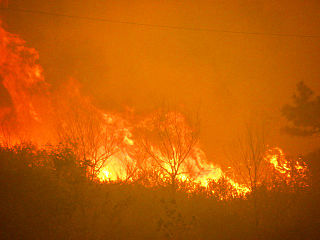
The 2012 Colorado wildfires were an unusually devastating series of Colorado wildfires, including several separate fires that occurred throughout June, July, and August 2012. At least 34,500 residents were evacuated in June.
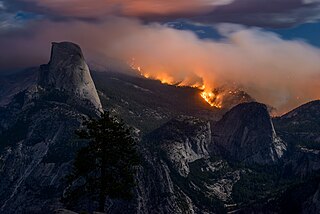
The Meadow Fire was a wildfire which burned areas near Half Dome in Yosemite National Park, California. Park officials believe it was started near Starr King Lake, during a lightning storm, on July 19, 2014. On Sunday, September 7, 2014 the fire forced authorities to order the evacuation by helicopter of dozens of hikers and tourists. On September 16, 2014 the fire burned 4,971 acres (2,012 ha) and was 80% contained. On September 18, the containment of the Meadow Fire increased to 85%, without having expanded further. During the next 4 days, firefighters were able to make significant progress on extinguishing the fire, especially with the 0.25 inches of rainfall during the weekend, and by September 22, the containment of the Meadow Fire had increased to 98%. From September 25 to 26, the containment of the wildfire still remained at 98%, despite some snow and rain falling in the region. On September 27, an additional inch of precipitation helped quench the wildfire, and on September 29, the Meadow Fire was 100% contained. No injuries or fatalities were reported.
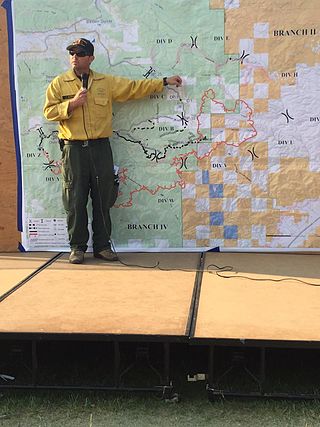
The Lake Fire was a wildfire that burned in the San Bernardino National Forest. The fire started on June 17, 2015, and burned over 31,359 acres before it was fully contained on July 21, 2015.

2015 Canadian wildfires were a series of wildfires across Canada and Alaska in July 2015 which spread smoke across most of North America. Over two hundred fires were ablaze across British Columbia, Saskatchewan, and Alberta.

The Barry Point Fire was a wildfire that burned over 92,977 acres (376.26 km2) of Oregon and California forest land during the summer of 2012. The fire began on 5 August 2012, the result of a lightning strike. The fire consumed public forest and rangeland as well as private forest and grazing land located in Lake County, Oregon and Modoc County, California. The public lands affected by the fire are administered by the United States Forest Service and the Oregon Department of Forestry. The largest part of the private land was owned by the Collins Timber Company. At the peak of the firefighting effort, there were 1,423 personnel working on the fire. It took 22 days to fully contain the fire and then an additional three weeks to mop it up.

The 2016 Southeastern United States wildfires were a series of wildfires in the Southeastern United States in October and November 2016. The U.S. Forest Service reported tracking 33 wildfires that had burned about 90,000 acres (36,000 ha).

The Schaeffer Fire was a wildfire in the Kern River Ranger District of the Sequoia National Forest in Tulare County, California in the United States. It was caused by a lightning strike on June 24, 2017. The fire crept through the old burn area of the 2002 McNally Fire for several days before growing to over 580 acres on June 28. The fire was contained by August 10 and destroyed a total of 16,031 acres (65 km2).

The Milli Fire was a wildfire that burned over 24,000 acres (97 km2) of Oregon forest land during the summer of 2017. The fire began in the Deschutes National Forest on 11 August 2017, the result of a lightning strike. The fire consumed thick forest vegetation southwest of Sisters, Oregon. Most of the burned area was public lands administered by the United States Forest Service, much of it in the Three Sisters Wilderness. Firefighters battled the blaze for over a month. At the peak of the firefighting effort, there were 675 firefighters working on the Milli Fire.

The 2018 Washington wildfire season officially began June 1, 2018. A statewide state of emergency was declared by Governor Jay Inslee on July 31.

The 2019 Alberta wildfires have been described by NASA as part of an extreme fire season in the province. In 2019 there were a total of 803,393.32 hectares, which is over 3.5 times more land area burned than in the five-year average burned. The five year average is 747 fires destroying 146,360.08 hectares. There were 644 wildfires recorded in Alberta. By May 31, 10,000 people had been evacuated, 16 homes, and the Steen River CN railway bridge, had been destroyed.

The Swan Lake Fire was a large lightning-caused wildfire that burnt between Sterling and Cooper Landing on the Kenai Peninsula in Alaska from June 5, 2019, until the autumn of that year. In total, the fire burned approximately 170,000 acres.
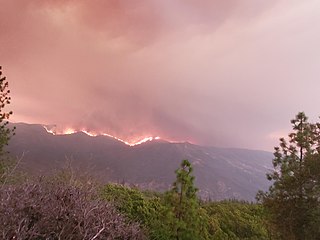
The August Complex was a massive wildfire that burned in the Coast Range of Northern California, in Glenn, Lake, Mendocino, Tehama, Trinity, and Shasta Counties. The complex originated as 38 separate fires started by lightning strikes on August 16–17, 2020. Four of the largest fires, the Doe, Tatham, Glade, and Hull fires, had burned together by August 30. On September 9, the Doe Fire, the main fire of the August Complex, surpassed the 2018 Mendocino Complex to become both the single-largest wildfire and the largest fire complex in recorded California history. On September 10, the combined Doe Fire also merged with the Elkhorn Fire and the Hopkins Fire, growing substantially in size. By the time it was extinguished on November 12, the August Complex fire had burned a total of 1,032,648 acres (417,898 ha), or 1,614 square miles (4,180 km2), about 1% of California's 100 million acres of land, an area larger than the state of Rhode Island.

The Cameron Peak fire was a wildfire that started near Chambers Lake, Colorado, 25 miles (40 km) east of Walden and 15 miles (24 km) southwest of Red Feather Lakes near Cameron Pass on August 13, 2020, and was declared 100% contained on December 2, 2020. The fire burnt 208,663 acres through the Arapaho and Roosevelt National Forests in Larimer and Jackson Counties and Rocky Mountain National Park. At its peak, the fire forced the evacuation of over 6,000 residents in Estes Park, Chambers Lake, Rustic, Glacier View Meadows, Red Feather Lakes, Masonville, Glen Haven, Spring Canyon, various small communities along Highway 14, Stove Prairie Landing Road, as well as the Colorado State University Mountain Campus and had over 1,000 personnel fighting the fire. 469 structures were destroyed by the fire, including 220 outbuildings and 42 primary residences. The fire became the largest wildfire in Colorado history, surpassing the Pine Gulch Fire, which had set the same mark just seven weeks prior.
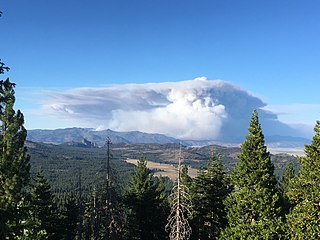
The Beckwourth Complex was a wildfire complex that burned in the Plumas National Forest in Plumas and Lassen counties. The two major fires of the complex, the Dotta Fire and the Sugar Fire, started on June 30 and July 2 northeast of Beckwourth, California. Started by lightning strikes, the two fires collectively burned 105,670 acres (42,763 ha). The complex resulted in the evacuation of numerous residential areas and the closure of portions of Plumas National Forest. In the community of Doyle, California, 33 homes were destroyed.

The Antelope Fire was a wildfire that burned in the Klamath National Forest, the Modoc National Forest, the Shasta-Trinity National Forest, and in Lava Beds National Monument in Siskiyou County, California, in the United States. The fire was started by a lightning strike and was first reported on August 1, 2021. As of October 15, the fire had burned 145,632 acres (58,935 ha).

The 2020 Maricopa County wildfires were a series of major and non-major wildfires that took place in Maricopa County, Arizona, from the month of May to the month of October. In the year 2020, Arizona saw one of its worst fire seasons in the states history. Due to the lack of precipitation needed in Arizona, the state fell into an ongoing drought from late 2020 and 2021. High winds were also present during the summer when fire season is mostly active in the state. These factors led to the wildfires in Maricopa County to be destructive and costly.

The 2023 Washington wildfire season officially began in March 2023 in the US state of Washington.
References
- 1 2 3 4 News, CBC (2010-08-22). "B.C. wildfire scorches 40,000 hectares" . Retrieved 2020-04-10.
{{cite news}}:|last=has generic name (help) - 1 2 3 4 5 6 "Ongoing Binta Lake forest fire rehab". Burns Lake Lakes District News. 2013-06-05. Retrieved 2020-04-10.
- ↑ Hansen, Darah (2011-07-05). "My Workplace". Vancouver Sun. Retrieved 2020-04-10.
- 1 2 3 "Cheslatta Carrier Nation". Indigenous Business and Investment Council. Retrieved 2020-04-10.
- 1 2 3 "Terrace Daily: BINTA LAKE FIRE CHALLENGES FIREFIGHTERS". www.mwpr.ca. Retrieved 2020-04-10.
- 1 2 "Kitimat Daily: FOREST FIRES GROW WITH GUSTY WINDS". www.kitimatdaily.ca. Retrieved 2020-04-10.
- ↑ HOEKSTRA, Gordon (15 June 2011). "Large Tisigar fire in northern B.C. gets rain break". Prince George Citizen. Retrieved 2020-04-10.
- ↑ "Wildfire smoke forces hospitals, merchants to lock doors" . Retrieved 2020-04-10.
- 1 2 "Four very large fires burning in US and Canada". Wildfire Today. 2010-08-23. Retrieved 2020-04-10.